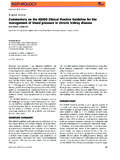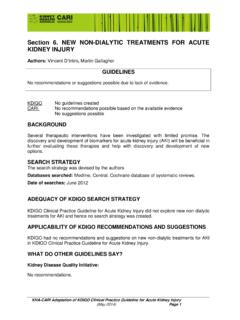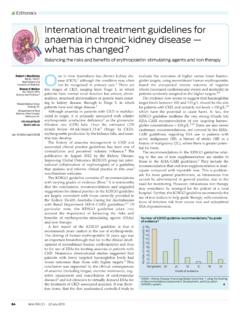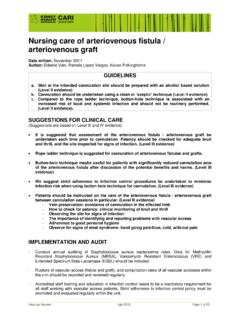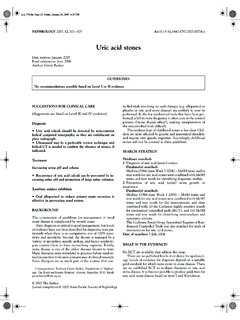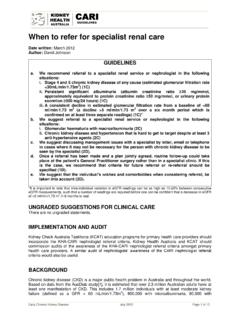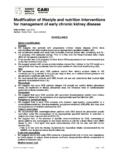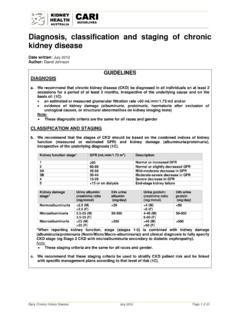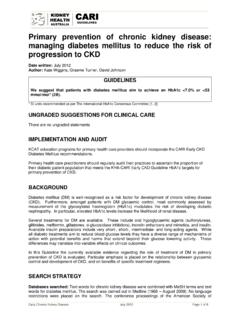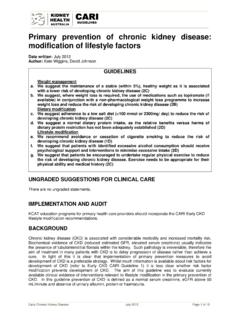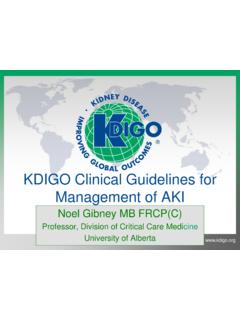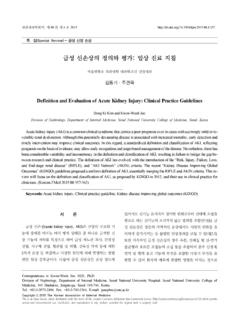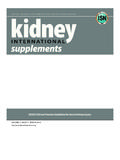Transcription of Section 1. DEFINITION AND CLASSIFICATION OF …
1 KHA-CARI Adaptation of kdigo clinical Practice Guideline for Acute Kidney Injury (May 2014) Page 1 Section 1. DEFINITION AND CLASSIFICATION OF ACUTE KIDNEY INJURY Authors: Zoltan Endre, Robyn Langham GUIDELINES a. We recommend using the kdigo DEFINITION to define and to stage functional change in AKI (Table 2). (refer to kdigo guideline) b. We recommend that all causes of AKI including contrast-induced-AKI be defined using the same criteria as other causes of AKI. (1D) c. We recommend that the cause of AKI be defined as soon as possible after diagnosis of AKI (1D) UNGRADED SUGGESTIONS FOR clinical CARE Biomarkers of kidney cellular damage should be incorporated into the AKI DEFINITION when sufficient cut-offs are available for each biomarker in the context of renal injury.
2 (Ungraded) Functional parameters in addition to structural parameters (determined by elevated biomarkers of structural damage) should be considered in determining the diagnosis, prognosis and outcome of AKI. (Ungraded) IMPLEMENTATION AND AUDIT Individual Units should consider an audit of definitions used to diagnose acute kidney injury (AKI) in separate clinical contexts and review against patient outcomes in those contexts. KHA-CARI Adaptation of kdigo clinical Practice Guideline for Acute Kidney Injury (May 2014) Page 2 BACKGROUND The following background is based on that provided in the kdigo guideline and edited to reflect the review conducted for the adaptation. Functional AKI is defined as any of the following: Fig 1: kdigo guidelines regarding the DEFINITION of AKI.
3 (Kidney International Supplements (2012) 2; 19) Fig 2. kdigo staging of AKI. (Kidney International Supplements (2012) 2; 19) KHA-CARI Adaptation of kdigo clinical Practice Guideline for Acute Kidney Injury (May 2014) Page 3 Fig 3. kdigo stage-based management of AKI diagram (Kidney International Supplements (2012) 2; 25). Acute kidney injury (AKI), formerly known as acute renal failure (ARF), is common, especially in hospitalised patients and is independently and strongly associated with morbidity and mortality. AKI is not a single disease, but a complex clinical syndrome that may arise in response to many etiologies, such as circulatory shock, sepsis and nephrotoxins [1]. The underlying pathophysiology of AKI is incompletely understood [2]. Early detection and treatment of AKI may improve outcomes.
4 The kdigo consensus DEFINITION of AKI combines two similar definitions based on SCr and urine output [3,4]. AKI is a subset of acute kidney disease (AKD) and can occur in the presence or absence of other acute or chronic kidney disease (Figure 4 and Table 3). KHA-CARI Adaptation of kdigo clinical Practice Guideline for Acute Kidney Injury (May 2014) Page 4 Fig 4. Overview of AKI, CKD and AKD. (Kidney International Supplements (2012) 2; 20 Fig 5. Table of definitions of AKI, CKD and AKD (Kidney International Supplements (2012); 2:33) SEARCH STRATEGY The search strategy was an update of that used by kdigo (refer to Table 21 in the Appendix of the kdigo guideline) (Kidney International Supplements 2 (2012); 2: 102-113). Additional key papers have been identified by the authors that were published after the KHA-CARI update search.)
5 KHA-CARI Adaptation of kdigo clinical Practice Guideline for Acute Kidney Injury (May 2014) Page 5 Databases searched: Medline, Central, Cochrane database of systematic reviews Date of searches: June 2012 ADEQUACY OF kdigo SEARCH STRATEGY The search strategy and evidence provided by kdigo was comprehensive and included some important randomised controlled trials (RCTs). A number of systematic reviews and RCTs have subsequently been identified in the updated search by KHA-CARI and included in this update. APPLICABILITY OF kdigo RECOMMENDATIONS AND SUGGESTIONS The kdigo recommendations are applicable to the Australian and New Zealand settings. OVERVIEW OF THE EVIDENCE The following provides an overview of the evidence as identified in the kdigo guidelines and the update searches conducted by KHA-CARI as part of the adaptation process.
6 DEFINITION The conceptual model of AKI (Figure 6) is analogous to the conceptual model of CKD and is also applicable to AKD [1,4]. The criteria for the diagnosis of AKI and stage of severity are currently based on changes in kidney function. It is widely recognized that GFR is the most useful overall index of kidney function in health and disease, and changes in SCr and/or urine output are surrogates for change in GFR. In clinical practice, an abrupt decline in GFR is assessed from an increase in SCr or oliguria. Changes in SCr are inevitably delayed after any step change in GFR and this will delay detection of AKI [4, 5]. Nevertheless, the current international and interdisciplinary consensus is based on two successive consensus definitions.
7 The modified RIFLE criteria proposed by ADQI [6] and the AKIN [7] which better account for small absolute changes in SCr not captured by RIFLE, comparison of both criteria demonstrate only small differences [3]. Epidemiological studies in over 500,000 subjects collectively support the validity of both criteria to identify groups of hospitalized patients with increased risk of death and/or need for RRT. However application of both RIFLE and AKIN criteria to a single large multicentre cohort of 14,536 patients with sepsis in the SAPS 3 database highlighted differences in the patients captured by the two criteria [8]. In particular AKIN captured mostly ( ) Stage 1 AKI missed by RIFLE and, in cases missed by AKIN and identified by RIFLE, 30% were RIFLE-I and 18% RIFLE-F.
8 These AKIN-missed cases had a hospital mortality that was similar KHA-CARI Adaptation of kdigo clinical Practice Guideline for Acute Kidney Injury (May 2014) Page 6 to cases identified by both criteria (37% for I and 41% for F). Similarly, the RIFLE missed cases that were identified as stage 1 AKI by AKIN, had double the hospital mortality rate (25%) of patients with no evidence of AKI by either criteria (13%). A further large retrospective single centre observational study of 4,836 consecutive patients undergoing cardiac surgery with cardiopulmonary bypass similarly demonstrated excellent association to outcome variables with worse outcome by increased severity of AKI regardless of whether AKIN or RIFLE CLASSIFICATION was used [9].
9 However, potential misclassification of AKI was higher in AKIN (in stage 1/RIFLE class R, because of the larger number of patients who developed a greater than mg/dl increase within a 48-hour diagnostic window after cardiopulmonary bypass surgery. Such patients were not misclassified by RIFLE since the increases in creatinine are referred to the baseline (pre-bypass) value. The authors noted that application of AKIN criteria in patients undergoing cardiac surgery without correction of serum creatinine for fluid balance may lead to over-diagnosis of AKI. These data provide a strong rationale for use of both criteria to identify patients with functional AKI but also the caveat discussed below that serum creatinine values should be corrected for fluid balance.)
10 Fig 6. Conceptual Model, figure modified after reference 4. SCr and urine output can only indirectly reflect that kidney damage has occurred. The availability of new biomarkers of kidney damage provides a new opportunity to identify patients with AKI in addition to SCr and urine output criteria. A large number of renal cellular damage markers have been identified over the last decade, many using genomic or proteomic strategies. The urinary biomarkers can be categorized [5] as filtered proteins increased due to KHA-CARI Adaptation of kdigo clinical Practice Guideline for Acute Kidney Injury (May 2014) Page 7 glomerular injury, such as albumin and protein, pre-formed markers released from damaged cells, such as the tubular enzymes gamma glutamyl transpeptidase and alpha- and pi-glutathione S-transferase, and biomarkers induced or up-regulated in response to cellular or tissue injury, including urinary neutrophil gelatinase-associated lipocalin NGAL, kidney injury molecule 1 (KIM-1), interleukin 18 (IL-18), cystatin C and liver-type fatty acid binding protein (L-FABP).
